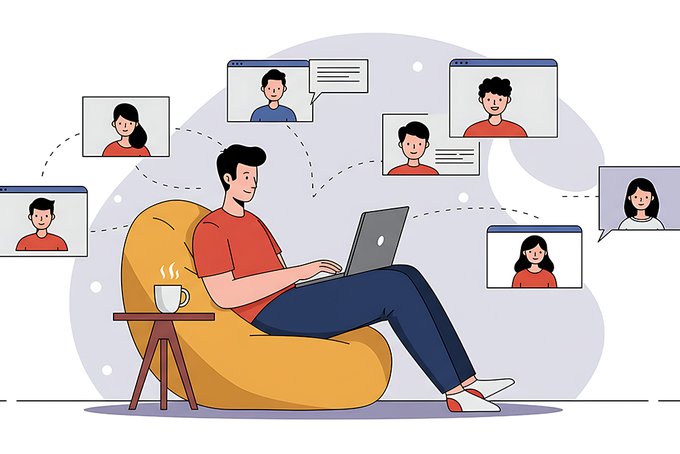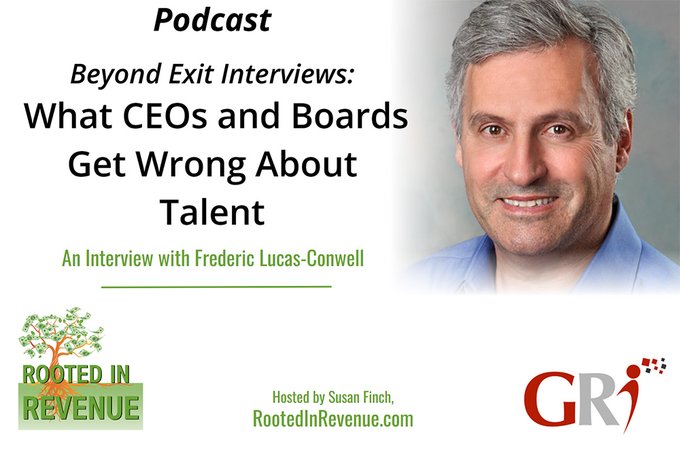The Future, Post-COVID: Extra Empathy, More Performance
Posted by Frederic Lucas-Conwell

The Future, Post-COVID: Extra Empathy, More Performance
They say that everything is clear in hindsight, so let’s jump forward to the year 2025 and take a look back at the year 2020.
Seen from 2025, how much has changed? 2020 was the year that the COVID-19 pandemic swept the world.
At the time, uncertainty and change were the only sure things. Workplaces, schools, and daycare centers closed abruptly. If your work could be done remotely you were required to work from home, without any preamble or preparation. Kids were home all day. Partners were also trying to adjust to the new WFH protocols.
As it became clear that this would be “normal” for a while, we started to adapt.
Startups and other flexible companies were surfing on the disruption not only with more technology but also with new business models open to distributed management and workforce. With a rapidly evolving demand and competitive landscape, companies were changing gears at high speed on all fronts including management.
The pivot for most managers was dramatic. They had to figure out how to inspire and motivate a workforce that was suddenly working remotely and was unusually distracted.
Office space suddenly became too expensive, and the way people socialized in those spaces underwent profound transformations. At-work and outside-work relationships formed through apps and digital interactions.
What Did the WFH Shift Look Like?
Mathew, a social media expert at a company in Sunnyvale California, started working from his home in Santa Cruz in March 2020 at the beginning of the lockdowns. Realizing that the situation would not revert, he and his partner wondered, “Could we experiment with a different lifestyle in Alaska while continuing to work remotely?” Grabbing the opportunity, they decided to move to Anchorage, continuing to work seamlessly for the same – now virtually-based – Silicon Valley company.

How did Angela, John and their four boys under the age of 12 make it work? Adaptable working hours from both of their companies helped them cope with remote schooling. They scheduled outdoor activities more often to recharge from jobs now taking up time and space under their roof, and instituted special family time during the weekends to make sense of all the change.
For Mathew, Angela, John, and many others around the world, the new WFH (work from home) mandate brought flexibility and efficacy, but also required rigor to balance personal and working hours.
At the same time, a new vision emerged for how managers could lead, and organizations could grow and prosper.
From Chaos We Built Trust and Identified Hidden Potential
COVID-times forced us to be mindful of ourselves and others more acutely than before.
For Mathew, and many of us in 2020, we were no longer able to learn about each other based on the little, everyday things that we took for granted before COVID: The way we dress, speak, walk, sit, eat, drink; the personal items on coworkers’ desks; the way we write or type on a phone.
The way we interacted, socialized, interviewed, on-boarded, and managed had to change, with no physical presence at all in many cases.
Working with contractors, bosses, and teammates in different time zones, relationships were based on teams feeling like they were pulling together. Instead of how everyone shows up and lives their personal life, the important factor was how the team interacts and delivers effectively toward the common goal.
Mathew described the building of trust and relationships at work as another version of his experience with online multiplayer video games, where the suit of armor he wears, or his gender, or skin color, are irrelevant. What matters are the skills that he puts into reaching his targets with a team loosely connected through the Internet.
The year of COVID invited everyone to pay attention to talent differently. It forced us to find empathy for the invisible potential hidden in each of us and our untapped capacity to collaborate more effectively. Respect and trust within teams started growing in different ways as well.
Seeing the Human Side
2020 was also a year of widening social divides - racism, xenophobia, other phobias, and social dilemmas. Being subject and sensitized to biases, reflecting on their potential cause, and mourning their effects, what was then the horizon for growing companies with a diverse dispersed workforce?
The COVID-times started us using new terms for what makes us human, unique, and talented, challenging the old consensus that focused on what made us different and potentially divisive.
Behaviors related to work became the focal point for better valuing how people can uniquely lead, learn, grow, adapt, and perform more efficiently, regardless of their gender, age, cultural origin, race, skin color, social class, or even formal education.
With remote work, it became evident that what employees do and how they do it was what mattered, not how they look like.
Our humanity is expressed through our behaviors. Assessing behavior, trusting what creates success in a given job from a behavioral standpoint, proved to be less biased and more accurate, allowed more of us to be successful more often, and let managers get the right person into the right position faster and with fewer mistakes.
Companies embraced the focus on behaviors initially because of the complexities inherent in remote work, but quickly found that it was a way to build a positive culture driven by performance, and to value everyone beyond the old, divisive dimensions and biases.
A Better Sense of Performance for Managers
In highly competitive markets where there is a constant need to outperform, the pandemic put additional pressure to innovate on people-related aspects. Post-COVID-times saw more realistic answers to intuit people’s emotions, understand what makes them tick, and bring the discipline it takes to manage people without waiting for costly issues to arise.
How much effort did everyone spend on a project or to prepare a presentation? What guidance and support did they need? How does this translate to Key Performance Indicators and revenues? How well would everyone collaborate and work after COVID?
Before COVID-times, how relationships build inside the company, how the culture forms and grows, what keeps people connected when working together were already being challenged, and changed.
With COVID came a more individualized, realistic understanding of each other's capabilities for growing performance as a team.
How to perform when physically distant opened new options for being less biased by how we look, walk, or speak. It forced us to appreciate how to better collaborate, serve a common purpose and deliver more value together.
The Impact
- Better decisions for oneself and others. Enhanced communication. Social skills and emotional intelligence more often expressed.
- Diversity and inclusion widely accepted.
- Positive attitudes at work showing through accrued interest and creativity.
The Indicators
- Cost and time to attract, engage, and retain people, and to create more meaningful work lowered.
- Number of interviews minimized.
- Number of years to educate managers and leaders reduced.
The Means
- More objective, realistic data and knowledge on people to identify their needs faster.
- Accuracy and consensus on job and team expectations.
The New Normal
Five years post-pandemic, in 2025, Michael is still enjoying his new lifestyle in Alaska. Being distanced physically from his manager helped build better communication and stronger relationships, away from unnecessary and unneeded day-to-day pressure. Quality work got delivered without it.

Back to normal after three years for Angela and John, their boys went back to school full time. The pair continue to enjoy flexible hours, less travel and more positive time together.
A local co-working space provides the environment to concentrate on work whenever needed. Their new house is a better fit for a large family of six, closer to outdoor activities.
Matthew, Angela, and John’s employers are thrilled with the enhanced productivity, while the three are living more balanced, satisfying lives.
It was taking up to three decades in pre-COVID-times to coach high standards of people management skills to leaders and managers.
Now, post-COVID, managers work with employees more like coaches of high-performing athletes who not only need self-awareness but also undivided attention from the coach tailored to their individual and group performance.
Managers benefit from knowing their candidates and teams better and faster than ever before, and do a better job at recruiting and managing them.
We might have been surprised back in 2020 if you had told us that the pandemic would create new and better ways of working. Yet now, five years later, organizations have adapted, with their people better able to understand, respect and take a competitive advantage from their differences.
Latest Articles
Hybrid Work: A Management Revolution
The COVID-19 pandemic has acted as an unprecedented catalyst, radically transforming our approach to work. What was once a marginal practice has become the norm for many...
Leadership 3.0: Objective Insights for People-Centric Leaders
Steve, a brilliant entrepreneur, poured his heart into his work. His team at "Innovatech" was on the brink of a major breakthrough, a new app that promised to revolutionize...
Transforming Boards: Unleashing the Power of Quiet Diversity
Two years ago, a private company's board witnessed a historic shift, appointing a black woman as Chairperson—a groundbreaking move for diversity. However, despite the outward...



